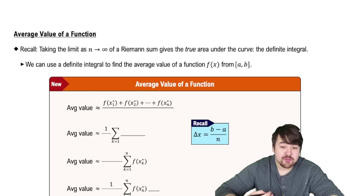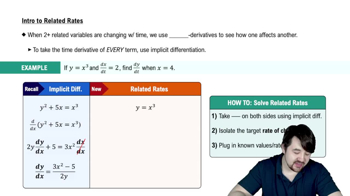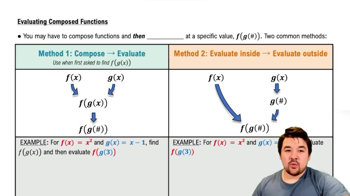a. Use a graphing utility to estimate lim x→0 tan 2x / sin x, lim x→0 tan 3x / sin x, and lim x→0 tan 4x / sin x.
Table of contents
- 0. Functions7h 54m
- Introduction to Functions16m
- Piecewise Functions10m
- Properties of Functions9m
- Common Functions1h 8m
- Transformations5m
- Combining Functions27m
- Exponent rules32m
- Exponential Functions28m
- Logarithmic Functions24m
- Properties of Logarithms36m
- Exponential & Logarithmic Equations35m
- Introduction to Trigonometric Functions38m
- Graphs of Trigonometric Functions44m
- Trigonometric Identities47m
- Inverse Trigonometric Functions48m
- 1. Limits and Continuity2h 2m
- 2. Intro to Derivatives1h 33m
- 3. Techniques of Differentiation3h 18m
- 4. Applications of Derivatives2h 38m
- 5. Graphical Applications of Derivatives6h 2m
- 6. Derivatives of Inverse, Exponential, & Logarithmic Functions2h 37m
- 7. Antiderivatives & Indefinite Integrals1h 26m
- 8. Definite Integrals4h 44m
- 9. Graphical Applications of Integrals2h 27m
- 10. Physics Applications of Integrals 3h 16m
- 11. Integrals of Inverse, Exponential, & Logarithmic Functions2h 31m
- 12. Techniques of Integration7h 41m
- 13. Intro to Differential Equations2h 55m
- 14. Sequences & Series5h 36m
- 15. Power Series2h 19m
- 16. Parametric Equations & Polar Coordinates7h 58m
1. Limits and Continuity
Introduction to Limits
Problem 2.1.22
Textbook Question
[Technology Exercise] 22. Make a table of values for the function at the points x=1.2, x=11/10, x=101/100, x=1001/1000, x=10001/10000, and x = 1.
a. Find the average rate of change of F(x) over the intervals [1,x] for each x≠1 in your table.
b. Extending the table if necessary, try to determine the rate of change of F(x) at x = 1.
 Verified step by step guidance
Verified step by step guidance1
First, identify the function F(x) that you need to evaluate at the given points. If the function is not provided, assume a general form or use a specific function from your textbook or exercise.
Create a table with two columns: one for the x-values (1.2, 11/10, 101/100, 1001/1000, 10001/10000, and 1) and another for the corresponding F(x) values. Calculate F(x) for each x-value using the function.
To find the average rate of change of F(x) over the intervals [1,x] for each x≠1, use the formula for the average rate of change: (F(x) - F(1)) / (x - 1). Compute this for each x-value in your table.
Extend the table if necessary by choosing x-values closer to 1, such as 100001/100000, to observe the behavior of the average rate of change as x approaches 1.
Analyze the pattern of the average rate of change as x approaches 1. This will help you determine the instantaneous rate of change of F(x) at x = 1, which is the derivative of F(x) at x = 1. Consider using limits to find this rate of change if needed.
 Verified video answer for a similar problem:
Verified video answer for a similar problem:This video solution was recommended by our tutors as helpful for the problem above
Video duration:
9mPlay a video:
Was this helpful?
Key Concepts
Here are the essential concepts you must grasp in order to answer the question correctly.
Average Rate of Change
The average rate of change of a function over an interval [a, b] is calculated as the difference in the function's values at the endpoints divided by the difference in the input values. Mathematically, it is expressed as (F(b) - F(a)) / (b - a). This concept is crucial for understanding how a function behaves over a specified range and is foundational for analyzing functions in calculus.
Recommended video:

Average Value of a Function
Limit and Instantaneous Rate of Change
The instantaneous rate of change of a function at a point is defined as the limit of the average rate of change as the interval shrinks to that point. This is formally represented using the derivative, where the derivative of F at x = a is given by F'(a) = lim (h -> 0) [(F(a + h) - F(a)) / h]. Understanding this concept is essential for determining how a function behaves at specific points.
Recommended video:

Intro To Related Rates
Function Evaluation
Function evaluation involves substituting a specific value into a function to determine its output. For example, if F(x) is a function, evaluating F(1) means finding the value of the function when x equals 1. This process is fundamental in creating tables of values and calculating rates of change, as it provides the necessary data points for analysis.
Recommended video:

Evaluating Composed Functions

 6:47m
6:47mWatch next
Master Finding Limits Numerically and Graphically with a bite sized video explanation from Patrick
Start learningRelated Videos
Related Practice
Textbook Question
